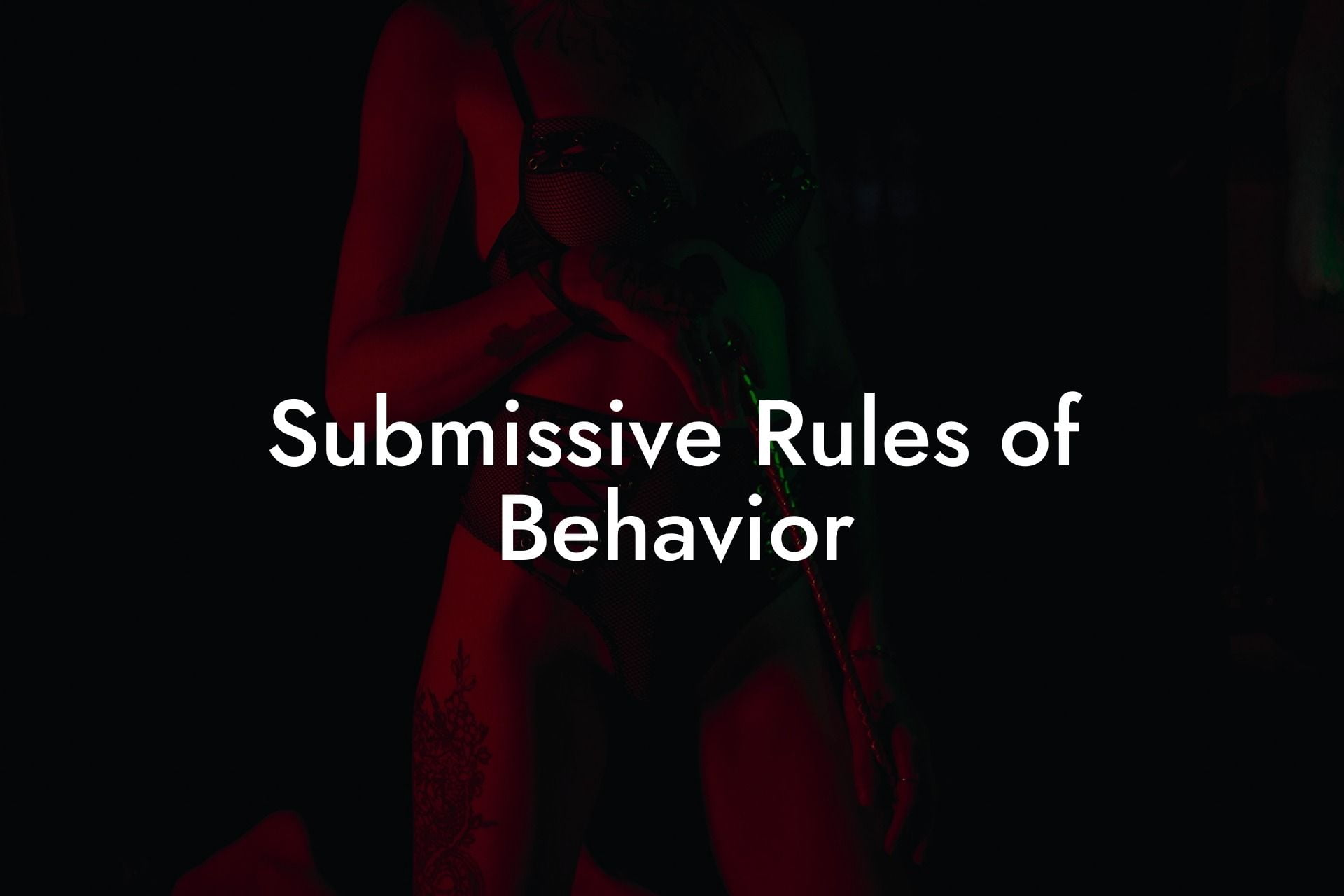---
Submissive Rules of Behavior are crucial for creating a safe and consensual environment within the BDSM community. Whether you're exploring your submissive side for the first time or seeking to enhance your understanding, this guide will provide you with valuable insights and essential guidelines. In this article, we will explore various submissive rules, from communication and consent to obedience and serving. Let's embark on this enlightening journey into the world of BDSM and submissive play.
Submissive Rule #1: Clear Communication
- Establishing open and honest communication with your Dominant is vital for a healthy BDSM relationship.
- Regularly discuss desires, limits, and boundaries to ensure the safety and fulfillment of all parties involved.
- Use safe words or signals to indicate discomfort or the need to pause or stop any activity.
Submissive Rule #2: Consensual Agreement
- Prioritize consent above all else. Consent should always be enthusiastic, informed, and ongoing.
- Understand that consent can be withdrawn at any point during a BDSM session.
- Discuss hard limits, soft limits, and explore ways to expand your comfort zone together.
Submissive Rule #3: Obedience and Discipline
- Establish and follow the rules set by your Dominant, ensuring they align with your agreed-upon boundaries.
- Embrace obedience as a form of surrender, focusing on trust and committing to the power dynamics of the relationship.
- Acknowledge that discipline may be an integral part of the submissive experience, helping to reinforce behavior and maintain structure.
Submissive Rule #4: Rituals and Protocols
- Explore rituals and protocols to enhance the power dynamic and intensify the submissive experience.
- Rituals can be as simple as a morning or evening routine or more complex involving specific gestures or actions.
- Protocols, such as addressing your Dominant with specific titles or requesting permission for certain activities, can deepen the sense of submission.
Submissive Rule #5: Training and Growth
- Embrace the continuous process of learning and personal growth within your submissive journey.
- Seek opportunities for education and self-improvement within the BDSM community.
- Understand that training is not about erasing your personality, but about enhancing your ability to serve and please your Dominant.
Submissive Rules of Behavior Example:
Imagine being in a BDSM relationship where clear communication, consent, obedience, and personal growth are integrated into your everyday life. You wake up each morning, perform a series of submissive rituals, and engage in intimate dialogue with your Dominant to reaffirm your commitment and explore new desires. As the day progresses, you embrace your assigned tasks and responsibilities, finding fulfillment in serving your Dominant. This realistic example showcases how submissive rules of behavior can reshape and enhance your BDSM experiences.
Frequently Asked Questions
What is a BDSM contract?
A BDSM contract is a document that outlines the terms, limits, and expectations of a relationship or scene involving BDSM activities. It acts as a communication tool to ensure all parties understand consent and agree to the power dynamics established.
How do BDSM contracts reinforce trust?
BDSM contracts reinforce trust by providing a clear and mutually agreed-upon framework in which both parties can express their desires and boundaries. They serve as a physical representation of the commitment to respect and adhere to the set guidelines.
Are BDSM contracts legally binding?
BDSM contracts, while useful for setting expectations, are not typically legally binding documents. They are more a symbol of agreement between the parties involved in a BDSM dynamic.
Can a BDSM contract be modified?
Yes, a BDSM contract can and should be modified if the needs, limits, or circumstances of either party change. Open communication is critical for a healthy BDSM dynamic, and contracts should reflect the current state of the relationship.
Is a BDSM contract necessary for all BDSM relationships?
No, a BDSM contract is not strictly necessary for all relationships. Whether to use one depends on the preferences of those involved. Some find contracts helpful, while others prefer verbal agreements and ongoing communication.
What does BDSM power dynamics mean?
BDSM power dynamics refer to the negotiated exchange of control between the dominant and submissive partner(s) within a BDSM scene or relationship. This can involve a wide array of practices and roles defined by the parties involved.
How do you negotiate power dynamics?
Negotiating power dynamics involves open, honest communication about each person's desires, hard limits, and soft limits. All parties should feel free to express what they want to experience and what they are not willing to engage in.
How important is consent in BDSM?
Consent is absolutely crucial in BDSM—it is the fundamental difference between abuse and a consensual power exchange. Consent must be informed, given freely, and can be revoked at any time during a scene or relationship.
Why is trust important in BDSM?
Trust is the cornerstone of any BDSM relationship or scene. It allows participants to be vulnerable and rely on each other to respect boundaries and adhere to the terms of their agreement. Without trust, the dynamic can easily turn harmful.
How can a submissive stay safe in a BDSM relationship?
A submissive can stay safe by thoroughly vetting their partner(s), setting clear boundaries, using a safeword, having a safety plan, and engaging in BDSM activities only with trustworthy individuals who respect their consent.
What is a safeword, and why is it important?
A safeword is a pre-agreed-upon word or signal used to immediately halt a scene if someone feels uncomfortable, in distress, or in pain beyond their threshold. It's a critical safety measure in BDSM play.
Does practicing BDSM carry any risks?
Yes, BDSM can carry physical and emotional risks. It is important to be aware of these risks, take steps to mitigate them through safe play practices, and ensure that both parties are well informed about the activities being engaged in.
How can dominants ensure they respect their partner's boundaries?
Dominants can respect their partner's boundaries by actively listening to their submissive's needs, adhering to the agreed-upon terms of the contract or negotiation, and checking in regularly to monitor their partner's well-being during a scene.
What should you do if a boundary is crossed?
If a boundary is crossed, the scene should be stopped immediately using the safeword or signal. Then, after ensuring the well-being of all parties involved, it's essential to discuss what happened and why, and to reevaluate boundaries and consent going forward.
How can I learn more about BDSM safety?
You can learn more about BDSM safety by reading reputable resources, attending workshops or seminars, and speaking with experienced practitioners in the BDSM community who share knowledge and guidance.
What role do negotiation and consent play in temporary BDSM scenes?
Negotiation and consent are fundamental in temporary BDSM scenes. Before a scene starts, all parties must communicate and consent to the activities, understand the duration and intensity, and establish safewords or other safety measures.
Can someone withdraw consent during a BDSM scene?
Absolutely. Consent is dynamic and can be withdrawn at any moment during a BDSM scene. When consent is withdrawn, activities should cease immediately.
Why might someone want to explore BDSM?
People may be drawn to BDSM for various reasons, including exploring power dynamics, experiencing intense physical sensations, finding emotional release, and engaging in creative role-play scenarios or fetishes.
How does aftercare contribute to BDSM safety?
Aftercare involves attending to both the physical and emotional needs of the participants after a BDSM scene. It's a crucial part of BDSM practice that helps in recovery, provides comfort, and confirms that all participants are well.
What is the difference between a hard limit and a soft limit?
A hard limit is a non-negotiable boundary that must not be crossed under any circumstances. A soft limit is a boundary that one may be willing to explore, but with much care and possibly within certain contexts or with specific conditions.
Are there any psychological risks involved with BDSM?
Like any intense emotional or physical activity, BDSM can carry psychological risks, such as triggering past traumas or causing emotional distress. These risks can be mitigated with good communication, established safewords, and aftercare.
How can individuals ensure their privacy when exploring BDSM?
Individuals can ensure their privacy by choosing trustworthy partners, carefully selecting private and secure venues for play, using pseudonyms within the BDSM community if desired, and safeguard private information and practices from non-consensual disclosure.
By understanding and implementing submissive rules of behavior, you can cultivate a deeply satisfying and fulfilling experience within the BDSM and kink world. Remember, open communication, enthusiastic consent, obedience, and personal growth are essential elements of a healthy submissive lifestyle. As you embark on your journey, continue exploring Filthy Adult for more informative resources, including our Ultimate BDSM Contract Pack, guides, and an extensive fetish shop. Don't forget to share this enlightening article with others who might find it valuable. Together, let's embrace and celebrate the beauty and complexity of the BDSM community.













